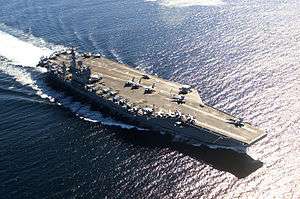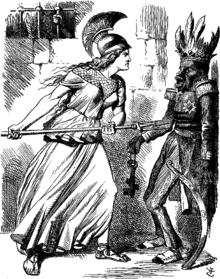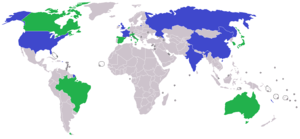Power projection

Power projection (or force projection) is a term used in military and political science to refer to the capacity of a state "to apply all or some of its elements of national power - political, economic, informational, or military - to rapidly and effectively deploy and sustain forces in and from multiple dispersed locations to respond to crises, to contribute to deterrence, and to enhance regional stability."[1]
This ability is a crucial element of a state's power in international relations. Any state able to direct its military forces outside the limited bounds of its territory might be said to have some level of power projection capability, but the term itself is used most frequently in reference to militaries with a worldwide reach (or at least significantly broader than a state's immediate area). Even states with sizable hard power assets (such as a large standing army) may only be able to exert limited regional influence so long as they lack the means of effectively projecting their power on a global scale. Generally, only a select few states are able to overcome the logistical difficulties inherent in the deployment and direction of a modern, mechanized military force.
While traditional measures of power projection typically focus on hard power assets (tanks, soldiers, aircraft, naval vessels, etc.), the developing theory of soft power notes that power projection does not necessarily have to involve the active use of military forces in combat. Assets for power projection can often serve dual uses, as the deployment of various countries' militaries during the humanitarian response to the 2004 Indian Ocean earthquake illustrates. The ability of a state to project its forces into an area may serve as an effective diplomatic lever, influencing the decision-making process and acting as a potential deterrent on other states' behavior.
History
Early examples of power projection includes Roman dominance of Europe: the ability to project power is tied to the ability to innovate and field such innovations. Roman engineering innovations such as machines (pile driver), concrete, aqueducts and modern roads provided the footing for an economic engine that powered a military that was unmatched in its day. Examples of Roman power projection include Julius Caesar building the Rhine bridge in 10 days to demonstrate the ability to march its 40000 troops as it sees fit: the local inhabitants enjoyed the natural protection of the river and fled when this natural protection was overcome. Although Rome is far from the center of modern-power, its influence can be seen in the architecture of modern capitols around the world (domes, arches, columns). The demonstration of an extraordinary innovative military capability will signal power and when properly applied terminate conflicts summarily.
The modern ability to project power and exert influence on a global scale can be tied to innovations stemming from the Industrial Revolution and the associated modernizations in technology, communications, finance and bureaucracy; this finally allowed the state to create unprecedented amounts of wealth and to effectively marshal these resources to exert power over long distances.
The first such industrial-technological power was the British Empire in the 19th century. As a maritime power, its strength and ability to project power to further its interests lay in the Royal Navy. A worldwide system of naval bases and coaling stations, a large logistical bureaucracy to oversee shipbuilding, the supply of coal, food, water, and sailors, and an industrial base for the manufacture and technological enhancement of the fleet were among the essential ingredients for this capability. During the First Opium War (1839–42), it was this capacity that enabled a British expeditionary force of 15 barracks ships, 4 steam-powered gunboats and 25 smaller boats with 4,000 marines to successfully defend its interests 6,000 miles from the fleet's home port.[2] The era of gunboat diplomacy that this inaugurated was an exercise in Western power projection, and was normally used in the defence of commercial and political interests.

The Anglo-French expeditionary force sent to shore up the Ottoman Empire against Russian aggression during the Crimean War (1853–56) was one of the first examples of a planned expeditionary power-projection campaign. It was the first campaign to use modern technology, including steam-powered warships and telegraph communications.
Another illustrative example of industrial power projection, was the punitive British Expedition to Abyssinia in 1868 as a retaliation against Emperor Tewodros II of Ethiopia's imprisonment of several missionaries and British government representatives. The expeditionary force sent was a tremendous logistical and technological challenge at the time. Commanded by Lieutenant-General Sir Robert Napier of the Bombay Army, military intelligence was used to estimate the required size of the army and the difficulties of traversing the inhospitable terrain.
A force of over 30,000 was shipped from British India to Zula on the Red Sea on a fleet of more than 280 steam ships, while an advance detachment of engineers built a large port with two piers, warehouses and a lighthouse, and constructed a 20-mile-long railway towards the interior.[3] A road was also built for the artillery to be moved along with the help of elephants. After three months of trekking, the British force repelled an Ethiopian attack and bombarded the fortress of Magdala into submission; Tewodros committed suicide.[4][5]
In the Russo-Japanese War of 1904–05, the Japanese destruction of the Imperial Russian Navy's Pacific Fleet demonstrated Imperial Russia's inability to project force in the East. This immediately diminished Russia's diplomatic sway in that region. At the same time, Russia's western armies became less credible, as mobilization exposed organizational flaws and threw the western armies into chaos. This led analysts in Europe, such as German chief of staff Count Alfred von Schlieffen, to conclude that Russia would prove inept at projecting force in Europe, thus demoting Russia in European diplomatic relations.
Many other actions can be considered projections of force. The 19th century is full of incidents such as the 1864 Bombardment of Kagoshima and the Boxer Rebellion. More recently, the Falklands War provided an example of the United Kingdom's ability to project force far from home. Other recent examples of power projection include the U.S.-led Invasion of Iraq and the NATO bombing of Yugoslavia. The ability of the U.S. Navy, the British Royal Navy, and the French Navy to deploy large numbers of ships for long periods of time away from home are notable projection abilities.
Elements

The U.S. Department of Defense defines power projection as the "ability of a nation to apply all or some of its elements of national power—political, economic, informational, or military—to rapidly and effectively deploy and sustain forces in and from multiple dispersed locations to respond to crises, to contribute to deterrence, and to enhance regional stability".[6][6]
As distance between a fighting force and its headquarters increases, command and control inevitably becomes more difficult. Modern-day power projection often employs high-tech communications and information technology to overcome these difficulties, a process sometimes described as the "Revolution in Military Affairs".
While a few long-range weapons such as the intercontinental ballistic missiles (ICBMs) are capable of projecting deadly force in their own right, it is military logistics that is at the heart of power projection. The ability to integrate naval and air forces with land armies as part of joint warfare is a key aspect of effective power projection; airlift and sealift capabilities facilitate the deployment of soldiers and weapons to a distant theater of war.
The aircraft carrier strike group, strategic bomber, ballistic missile submarine, and strategic airlifter are all examples of power projection platforms. Military units designed to be light and mobile, such as airborne forces (paratroopers and air assault forces) and amphibious assault forces, are utilized in power projection. Forward basing is another method of power projection, which, by pre-positioning military units or stockpiles of arms at strategically located military bases outside a country's territory, reduces the time and distance needed to mobilize them.
Types
Scholars have disaggregated military power projection into nine different categories based on political goals and level of force. Four of these employ "soft" military power (securing sea lanes of communication, non-combatant evacuation, humanitarian response, and peacekeeping) and the rest are primarily concerned with "hard" military power (showing the flag, compellence/deterrence, punishment, armed intervention, and conquest).[7]
Soft power
Examples of soft power projection include:
- Securing sea lanes of communication: the protection of shipping lanes from attack by hostile states or irregular threats.
- Non-combatant evacuation operations: the evacuation of citizens or friendly third-country civilians from a foreign country when they are endangered by war or civil unrest.
- Humanitarian response: the use of military forces abroad to assist in the aftermath of a natural disaster.
- Peacekeeping: military operations designed to support diplomatic efforts to reach a long-term political settlement to an ongoing dispute.
Hard power
Examples of hard power projection include:
- Showing the flag: the symbolic deployment of military forces to a region for the purposes of demonstrating political interest, resolve, or willingness to take more forceful military action.
- Compulsion/deterrence: the use of the threat of military force against another state to either induce it into or dissuade it from pursuing a given policy. In this form, power projection acts as a diplomatic tool, attempting to influence the decision-making process of foreign actors.
- Punishment: the punitive use of force against another state in response to their pursuit of a given policy.
- Armed intervention: the movement of military forces into another nation’s territory for the purposes of influencing the internal affairs of the target country short of outright conquest.
- Conquest: the offensive use of military assets to forcibly occupy territory controlled or claimed by another state.
Examples of power projection
In the Russo-Japanese War of 1904–1905, the Japanese destruction of the Imperial Russian Navy's Pacific Fleet demonstrated Imperial Russia's inability to project force in the East. This immediately diminished Russia's diplomatic sway in that region. At the same time, Russia's western armies became less credible, as mobilization exposed organizational flaws and threw the western armies into chaos. This led analysts in Europe, such as German chief of staff Count Alfred von Schlieffen, to conclude that Russia would prove inept at projecting force in Europe, thus demoting Russia in European diplomatic relations.
Many other actions can be considered projections of force. The 19th century is full of these incidents, such as the 1864 Bombardment of Kagoshima and the Boxer Rebellion. More recently, the Falklands War provided an example of the United Kingdom's ability to project force far from home. The ability of the U.S. Navy, the British Royal Navy, and the French Navy to deploy large numbers of ships for long periods of time away from home are unique projection abilities.
The U.S. Department of Defense defines power projection as the ability of a nation to apply all or some of its elements of national power - political, economic, informational, or military - to rapidly and effectively deploy and sustain forces in and from multiple dispersed locations to respond to crises, to contribute to deterrence, and to enhance regional stability.[6]
Meanwhile, critics of US foreign policy argue that power projection is not merely the ability to stabilize a given area of the world for regional security, but rather as means of discipline and control over the politics, economy and order of states. Noam Chomsky, a critically acclaimed author and activist argued "In the Middle East, they are doing everything they can to ensure that Iraq remains an obedient client state that serves as a base for US power projection in the region and permits free exploitation of its rich oil resources by Western (primarily US) corporations. That much is evident from ongoing activities and formal pronouncements."[8]
See also
- Expeditionary warfare
- Blue-water navy
- Expeditionary maneuver warfare
- Unsinkable aircraft carrier
- Military deployment
- Military logistics
- Loss of Strength Gradient
- Over-the-beach capability
- Seabasing
- Sovereignty
References
- ↑ US Department of Defense (2013). The Dictionary of Military Terms. New York: Skyhorse Publishing.
- ↑ The London Gazette: no. 19930. pp. 2990–2991. 15 December 1840.
- ↑ Moorehead, Alan (1972). The Blue Nile. New York: Harper and Row. p. 266.
- ↑ Rubenson, Survival, p. 268
- ↑ Ferguson, Niall (2008). Empire: The Rise and Demise of the British World Order and the Lessons for Global Power. Basic Books.
- 1 2 3 United States Department of Defense. J1-02: Department of Defense Dictionary of Military and Associated Terms.
- ↑ Ladwig III, Walter C. (November–December 2010). "India and Military Power Projection: Will the Land of Gandhi Become a Conventional Great Power?". Asian Survey. 50 (6): 1162–1183. doi:10.1525/as.2010.50.6.1162.
- ↑
External links
| Wikimedia Commons has media related to Power projection. |
- US Army Field Manual 100-10 Chapter 1: Power Projection
- US Army Field Manual 100-7 Chapter 6: Force Projection
